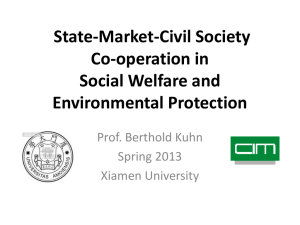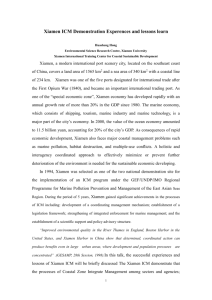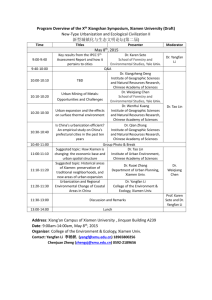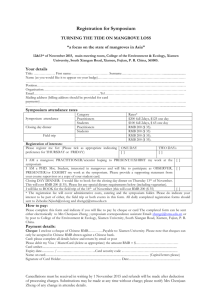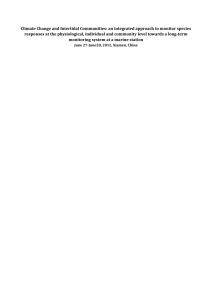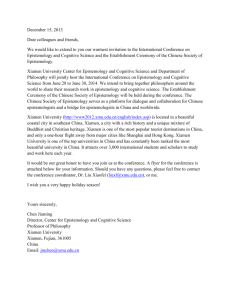CRITICAL SUCCESS FACTORS & RISKS IN PROPERTY INVESTMENT IN CHINA
advertisement
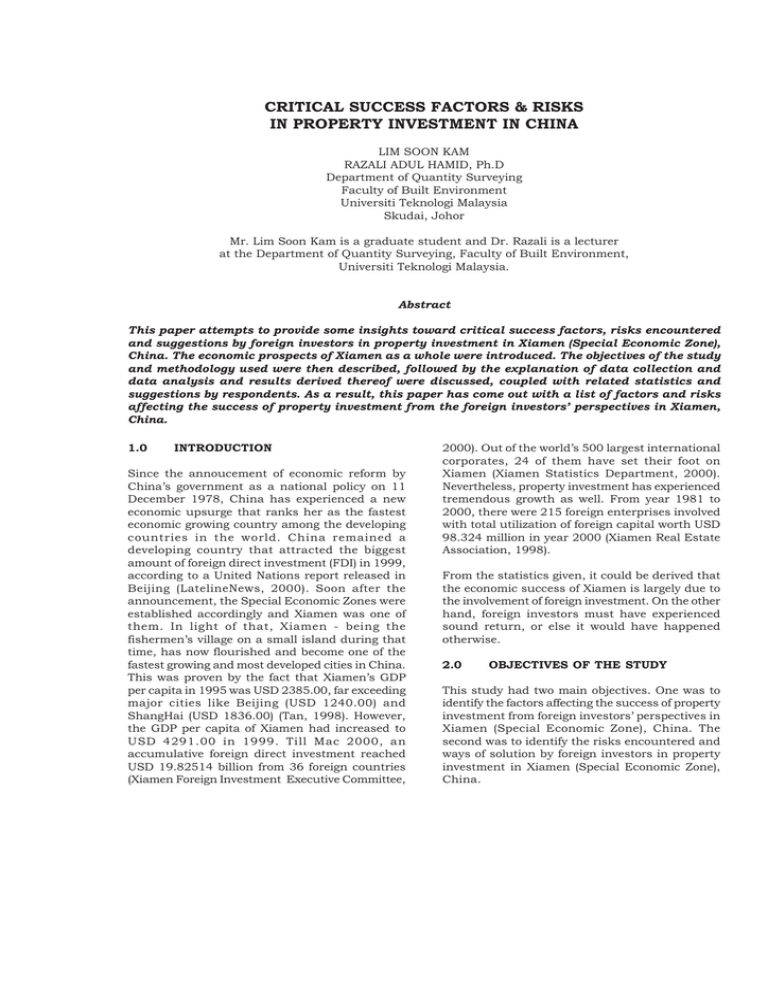
CRITICAL SUCCESS FACTORS & RISKS IN PROPERTY INVESTMENT IN CHINA LIM SOON KAM RAZALI ADUL HAMID, Ph.D Department of Quantity Surveying Faculty of Built Environment Universiti Teknologi Malaysia Skudai, Johor Mr. Lim Soon Kam is a graduate student and Dr. Razali is a lecturer at the Department of Quantity Surveying, Faculty of Built Environment, Universiti Teknologi Malaysia. Abstract This paper attempts to provide some insights toward critical success factors, risks encountered and suggestions by foreign investors in property investment in Xiamen (Special Economic Zone), China. The economic prospects of Xiamen as a whole were introduced. The objectives of the study and methodology used were then described, followed by the explanation of data collection and data analysis and results derived thereof were discussed, coupled with related statistics and suggestions by respondents. As a result, this paper has come out with a list of factors and risks affecting the success of property investment from the foreign investors’ perspectives in Xiamen, China. 1.0 INTRODUCTION Since the annoucement of economic reform by China’s government as a national policy on 11 December 1978, China has experienced a new economic upsurge that ranks her as the fastest economic growing country among the developing countries in the world. China remained a developing country that attracted the biggest amount of foreign direct investment (FDI) in 1999, according to a United Nations report released in Beijing (LatelineNews, 2000). Soon after the announcement, the Special Economic Zones were established accordingly and Xiamen was one of them. In light of that, Xiamen - being the fishermen’s village on a small island during that time, has now flourished and become one of the fastest growing and most developed cities in China. This was proven by the fact that Xiamen’s GDP per capita in 1995 was USD 2385.00, far exceeding major cities like Beijing (USD 1240.00) and ShangHai (USD 1836.00) (Tan, 1998). However, the GDP per capita of Xiamen had increased to USD 4291.00 in 1999. Till Mac 2000, an accumulative foreign direct investment reached USD 19.82514 billion from 36 foreign countries (Xiamen Foreign Investment Executive Committee, 2000). Out of the world’s 500 largest international corporates, 24 of them have set their foot on Xiamen (Xiamen Statistics Department, 2000). Nevertheless, property investment has experienced tremendous growth as well. From year 1981 to 2000, there were 215 foreign enterprises involved with total utilization of foreign capital worth USD 98.324 million in year 2000 (Xiamen Real Estate Association, 1998). From the statistics given, it could be derived that the economic success of Xiamen is largely due to the involvement of foreign investment. On the other hand, foreign investors must have experienced sound return, or else it would have happened otherwise. 2.0 OBJECTIVES OF THE STUDY This study had two main objectives. One was to identify the factors affecting the success of property investment from foreign investors’ perspectives in Xiamen (Special Economic Zone), China. The second was to identify the risks encountered and ways of solution by foreign investors in property investment in Xiamen (Special Economic Zone), China. 3.0 METHODOLOGY The questionnaire was designed in 2 languages (English and Mandarin) based on literatures and consultation with relevant professionals. There were 4 main parts in the questionnaire: (1) general personal details; (2) general company details; (3) opinions regarding the factors (categorized into internal and external factors) affecting the success of property investment from foreign investors’ perspective in Xiamen, China; and (4) opinions regarding the risks encountered and suggestions of solution for risks encountered by foreign investors in property investment in Xiamen, China. For the purpose of this study, the author had visited Xiamen, China for a period of one month. Guided by the help of professionals concerned in Xiamen and reference made to Fujian Foreign Investment Enterprises Directory, 13 sats of questionnaire were distributed in person to selected significant respondents. The respondents selected were from foreign companies either have completed at least a property development project or made profits in property investment in Xiamen. Besides the questionnaire responses, face-to-face interviews were conducted to clarify any doubtful issues while completing the questionnaire and also to acquire a realistic overview of what actually happened on property investment in Xiamen. The questionnaires distributed were then collected and analysed. 4.0 DATA COLLECTION Out of 19 significant respondents identified, a total of 13 responses were obtained. The data was collected immediately after an average of 40 minutes’ face-to-face interview with each of the respondents. Respondents were requested to provide some detail information. However, some difficulties were met due to the nature of information, which deemed confidential by some of the foreign companies. On the other hand, those who were convinced to participate satisfactorily answered most of the questions asked. The companies responded were from 6 major countries that involved in property investment in Xiamen. They were from Hong Kong, Taiwan, Singapore, Macau, Malaysia and Philipines. 5.0 DATA ANALYSIS Data collected was analysed using 2 methods. They were frequency analysis method for Part 1 and Part 2, whereas Likert Scaling method for Part 3 and Part 4 in the Questionnaire. Quantitative judgement was employed in Likert Scaling method by using 5 scaling points representing the ascension degree of importance for the factors (Part 3) and severity for the risks (Part 4). Total score for each factor and risk was calculated, followed by min score and finally the scale index was formed in order to categorize the the degree of importance for the factors and severity for the risks. Factors analysis in Part 3 was divided into 2 sections: internal and external factors. The categorized internal factors signified that they were under the control of the foreign investors; external factors were not. Part 4 comprised of 2 sections: risks analysis and suggestion by the respondents of ways of solution towards risks encountered. In suggestion section, the respondents had categorized risks into 2 different natures: controllable and uncontrollable. 6.0 DISCUSSION OF RESULTS Part 1: General Personal Details 76.92% Of the respondents were from middle management officials of the foreign companies. Posts held were like Vice General Manager, Project Development Manager, Sales & Marketing Manager and Financial Manager, giving an opinion from diverse perspectives with professional insights. However, 84.62% of the respondents were of Chinese nationality. This has thus relected the actual scenario of foreign companies’s employment of local workers to serve in their companies, due to comparatively much cheaper employment than expatriates, though professionals. Furthermore, the local professionals and workers are more attuned to China’s working culture. Most of the respondents fall on category below 26–35 of age with 5–15 years of working experience. 100% Of them were graduates from universities. This suggests that they have certain level of professional knowledge and capability and maturity in their field of service that directly contributed to the accuracy and reliability of the opinions given to the Questionnaire. Part 2: General Company Details The origins of the companies of respondents were mainly from Hong Kong, Singapore, Taiwan, Philipinnes, Malaysia and Macau. According to Xiamen Foreign Investment Executive Committee, Hong Kong registered companies have topped all the other countries in property investment in Xiamen with 167 companies out of 215, giving a total of 77.67%. This is followed by Taiwan (30), Singapore (13), Malaysia and Philipinnes (2 each) and Macau (1). Informal findings revealed that overseas Chinese owned 100% of the responded companies. This phenomenon has a say towards the common culture shared and possessed by both geografically separated Chinese. 53.85% Of the companies been established between 6-10 years. At the same time, 69.23% of them have number of staff above 35. This suggests that a company takes 6–10 years to be successful and established. 92.31% Stated that they have staked an investment worth RMB 150 million and above in property development. The actual investment value was, however, inavailable due to the confidential nature of the information. Nevertheless, it gives an indication that to be successful in property investment in Xiamen, one needs to have a favorable sum of capital with at least millions of dollars. 84.62% Of the companies agreed that the main reason to investing in China is the size and potentiality of China’s market. No answer was given to cheap labor and land cost. Some said that they have businees connections in China. This has again confirmed the fact that China, as the most populous country remains attractive to the rest of the world. The total number of projects involved by the companies was 70 and 40 of which have been completed on time, giving an average of 57.14% for its total project completion. An average of expected profit normally set by the companies was 19.70%. However, in reality, an average of actual profit normally gained was 17.70%, giving accuracy to its expected profit up to 89.70%. These figures have thus suggested that foreign investors have gained favorable yield on their property investments. Part 3 (a) : Respons Regarding the External Factors Affecting the Success of Property Investment from Foreign Investors’ Perspective in Xiamen, China. Table 1: Lists down the respondents opinions regarding the external factors affecting the success of property investment in Xiamen, China. 1234567890123456789012345678901212345678901234567890123456789012123 1234567890123456789012345678901212345678901234567890123456789012123 1234567890123456789012345678901212345678901234567890123456789012123 Table 1: List of External Factors According to 1234567890123456789012345678901212345678901234567890123456789012123 1234567890123456789012345678901212345678901234567890123456789012123 1234567890123456789012345678901212345678901234567890123456789012123 Degree of Importance 1234567890123456789012345678901212345678901234567890123456789012123 1234567890123456789012345678901212345678901234567890123456789012123 Category of Importance Most Important Very Important Important Slight Important Not Important External Factors Diplomatic Relationship Property Demand Infrastructure Facilities Location of Xiamen Preferential Policies Land Cost Construction Cost Migration Local Standard of Living From Table 1, it can be seen that Diplomatic relationship between government of foregein investors’ countries and the government of China was deemed as the most important factor in order to be successful in property investment in Xiamen, China. This was because a good diplomatic relationship serves as a “warm welcoming door” at the initial stage before foreign investors enter into China’s market and thereby made easy the way in the later stage, especially dealing with government’s complicated procedures. Property demand in Xiamen had shown an increase based on various achievements (refer Appendix 1). The total investment in property development had increased from RMB 5,987.81 million in 1995 to RMB 7,625.28 million in 1998, whereas the total floor space of building completed had increased from 1.7087 million m2 in 1995 to 2.3193 million m2 in 1999, so as the average value property per m2 had increased from RMB 1,047/m2 in 1995 to RMB 1,751/m2 in 1999. Furthermore, an average residential space per person had also increased from 9.40 m2/person in 1995 to 12.60 m2/person in 1999. Infrastructure facilities in Xiamen are comprehensive with good transportation system including Xiamen Gaoqi International Airport and well-developed highway system, quick and convenient connection of telecommunication, variety of banking services, international Port of Xiamen and etc. This has contributed to the inceasingly property demand in Xiamen as well as attracted foreign investors to continuously flow in. From geographical point of view, Xiamen is strategically located in MingNan Golden Triangle that serves as the economic nucleus in Fujian Province. The unsilted 64.5 km natural coastal line with deep water, vast area, mild waves and ice-free has made Xiamen port an important entreport in Min Nan region. Moreover, its clossness to Taiwan has further triggered the Xiamen’s economy. This uniqueness has kept attracting foreign investors who intend to penetrate China’s market to establish their base in Xiamen. In other words, Xiamen becomes as a “window” to get familiarized with China and a “platform” in order to leap into the China’s vast inner market. Preferential policies are being widely offered to various fields of investment. Most of the foreign investors are enjoying variety of incentives and tax-exemption in the beginning few years of investment (refer Appendix 2). However, foreign investors sometimes may have to negotiate incentives and benefits with the relevant government authorities; some incentives and benefits may not be automatically conferred (U.S Embassy, 1999). Land cost factor was deemed important by the respondents because one has to be highly competitive in securing land which strategically located, in order to boost property sales in later stage. Because of that, the price of land becomes doubly expensive as rented from the local government. It should be noted that the foreign invested interprises in China can obtain land use rights but without its ownership (Jin, 1994). The land used should be returned when the time limit expires (refer Appendix 3). Construction cost factor remains as slight importance because China has a vast resource to be tapped. This is proven by the fact that its labours (refer Appendix 4), materials, machinery and professional services are comparatively cheaper and easily available here in China. Practically, one does not necessarily import anything except for exceptional few items. The respondents regarded migration factor as not important. This was so because the government controls the migration and immigration of residents in China, especially Special Economic Zones and other designated zones and localities. In Xiamen, the total migrants and immigrants were almost equally the same with slight difference from the year 1995 to1999 (refer Appendix 5). If the social welfare and living standard of Xiamen were to be examined, one would readily thumbsup (refer Apendix 6). However, the respondents still deemed standard of living as a factor of no importance. This suggests that this factor was relatively not important compared to other factors. Part 3 (b) : Respons regarding the Internal Factors Affecting the Success of Property Investment from Foreign Investors’ Perspective in Xiamen, China. Table 2 : List the views of the respondents regarding the internal factors affecting the success of property investment in Xiamen, China. 1234567890123456789012345678901212345678901234567890123456789012123456 1234567890123456789012345678901212345678901234567890123456789012123456 1234567890123456789012345678901212345678901234567890123456789012123456 1234567890123456789012345678901212345678901234567890123456789012123456 Table 2: List of Internal Factors According to 1234567890123456789012345678901212345678901234567890123456789012123456 1234567890123456789012345678901212345678901234567890123456789012123456 Degree of Importance 1234567890123456789012345678901212345678901234567890123456789012123456 1234567890123456789012345678901212345678901234567890123456789012123456 1234567890123456789012345678901212345678901234567890123456789012123456 Category of Importance Most Important Very Important Important Slight Important Not Important External Factors Personal Relationship Company Management Information Capital Knowing Chinese Culture Building Style & Design Employment of Local Resources Interaction with Overseas Headquater Overseas Investment Experience Continuity of Projects Joint-venture with Local Firms Table 2 shows that the respondents deemed personal relationship or more commonly known as “guanxi” in China as most important factor not only in the case of Xiamen, but China as a whole regardless of any form of investment or business. According to them, if personal relationship is good with government officials, many advantages could be ganed including smoothness in regards with governmnent procedures, which are usually complicated Some even argued that if you have a good personal relationship with any of an influential man in China, a complicated matter could be simplified and a small matter could be made non-existence. In short, a good personal relationship will minimize the cost of uncertainties. and more attuned to China’s working culture. This suggests that a foreign investor should take consideration of Chinese way of doing things in his company management, thereby made smooth the whole investment process in China. As has been mentioned before, most of the employees in the foreign companies were local Chinese working below top management posts. Only selected few with experience were holding top management posts like Chief Executive Officer (C.E.O) or General Manager. Expatriates normally hold these top management posts. Again, this could due to cheap local employment and advantageously the local Chinese are well-versed The respondents argued that capital has to be solidly strong in order to be successful in property investment in Xiamen. 92.31% stated that they have staked an investment worth RMB 150 million and above in property development (refer Part 2). Besides working capital, one has to have strong back-up capital to deal with unforseen to extra capital. Information has to be tapped fast, accurate, on time and in concurrent with the market trend in order to establish good property sales and to avoid unnecessary costs. This involves information like current desirable building style and design, local purchasing power, incentives being offered, changing of rules by government and etc. A slow in this regard will definitely affect investment yield, due to large sum of capital injected and still competitious within the industry. Knowing Chinese culture is very important to understand and their minds their buying property behaviour. For instance, a typical Chinese doesn’t like any number property with digit “4” which means “death” if it were to be literally translated into one of Chinese dialects. This is so reflected when they buy property. Meanwhile, foreign investors have to keep apar with current desirable building style and design in their property development. Informal observation has shown that high-rise residential buildings in Xiamen normally do not exceed 7 storeys. According to residents they do not prefer to stay high up because fear of danger. However, from economic point of view, the maintenance cost for a building above 7 storeys is comparatively higher than those not exceeding 7 storeys. This is because the local government requires developers to install lifts in any building above 7 storeys. Informal observation also revealed that many new residential buildings are Western or Europe styles. Besides, the locals prefer buying houses within so-called “small village” residential concept. In this concept of development, they have shops, schools, markets and other facilities within its easily reachable vicinity. Employment of local resources is very important for foreign investors. In short, there are 3 main advantages to be tapped if local resources were to be employed by foreign investors: (1) cost saving, (2) easily and voluminously available and (3) suitably applicable due to its nature that fits its environment. However, there are cases where resources have to be imported from outside China. Nevertheless, it consists only a few due to the nature of property development whichs needs but conventional construction method. Normally proposals have to be sent from China’s office to overseas headquarter for any decision to be made on investment. This is because overseas headquarter holds the ultimate say. Some respondents argued that many a time misunderstandings happened between China’s employees and employees in overseas headquarter, due to respective cultural and background differences, though Chinese. It thus suggests that a frequent interaction with overseas headquater is very important to safeguard the whole investment process in China. On the other hand, the respondents argued that having overseas investment experience is also very important to accelerate and enhance the adaptability of foreign investors in a newly invested country. Fundamentally, the process of property investment is likely the same only differs according to different locality. Continuity of projects factor was deemed very important in order to continuously generate income, tapping the existing market demand. As a whole, Xiamen’s property market had shown a positive growth from the year 1995 to 1999 (refer Appendix 1). However, it was still dependent on type of property development. For example, in year 1999, Xiamen’s property market had shown an oversupply of offices; on the other hand, the market of residential and commercial buildings remained positive (refer Apendix 7 & 8). This figures suggest that in the coming few years, offices building would not be an ideal investment for investors. The respondents considered that joint venture with local firms has no importance in affecting the success of foreign investors investing property in Xiamen. They argued that joint venture with local firms will create many inconvenience which results the slow-down of whole investment process. “Market waits nobody”, said a respondent. It can be seen from Table 3 that Political instability between China and Taiwan remains as a threat to foreign investors. Geographically, Jingmen Island owned by Taiwan is just few hundreds meters away from Xiamen. Foreign investors always feel the intensity of political quarrel. However, recent political improvement between 2 countries as reflected in direct link between Xiamen and Jingmen Island has pushed foreign investors to be more optimistic. Some respondents said that another economic boom in Xiamen is expected to happen if direct link between 2 localities were to be fully implemented. Frequent changes in policies have indeed complicated and made slow the whole investment process. But government argued that there is a lot of policy imperfection that needs to be rectified since Xiamen as the Special Economic Zone is still new from its inception. Whatever the case, in the long run, it is for the benefits of all. According to Xiamen Real Estate Information, from 1981 to April 1999, there were 563 companies investing in property. Chinese investors owned 349 of them (61.99%), whereas foreign investors Part 4 (a) : Opinions regarding the Risks Encountered by the Foreign Investors Table 3 shows views of the respondents regarding the risks encountered by foreign investment in property development in Xiamen, China. 12345678901234567890123456789012123456789012345678901234567890121234567890123456789012 12345678901234567890123456789012123456789012345678901234567890121234567890123456789012 12345678901234567890123456789012123456789012345678901234567890121234567890123456789012 Table 3 : List of Risks According to 12345678901234567890123456789012123456789012345678901234567890121234567890123456789012 12345678901234567890123456789012123456789012345678901234567890121234567890123456789012 Degree of Severity 12345678901234567890123456789012123456789012345678901234567890121234567890123456789012 Category of Severity Most Severe Very Severe Severe Slight Severe Not Severe Risks Controllable Political Situation Changes in Policies Competition within industry Market Sales level of Technology Legal Framework Bureaucratic Structure Income Availability of Credit Interest Rate Local Resources Currency Exchange Rate Force Majeure Inflation Chinese Culture owned 214 companies (38.01%). The property industry is thereby very competitive. Due to competitiveness within the industry, foreign investors find difficulty in property market sales, especially offices building (refer Apendix 7 & 8). However, marketability for buildings that are strategically located is still high (HaiXiaDaoBao, 2000). Differences in the level of technology employed by foreign investors in their land of origins and China have thus created certain level of risk. The respondents argued that it is advisable for foreign investors to adapt themselves with local technology rather than to employ theirs in China. In short, adjustment has to be made by both parties to come to a common technological-agreeable ground. Although more than 150 majors laws and regulations apply to foreign investment, China’s legal and regulatory system remains characterized by a general lack of transparency Uncontrollable / / / / / / / / / / / / / / / and inconsistent enforcement (U.S. Embassy, 1999). In this regards, foreign investors may also face excessive bureaucratic influence, which complicates the whole investment process. Though there have been legislation and regulations on foreign investment, these laws and regulations are still fraught with ambiguities, and foreign investor has no prospective without experienced counsel (U.S. Embassy, 1999). Appendix 9 shows income generated from property sales and rental by foreign investors in Xiamen in year 1999. Informal data revealed that some foreign companies not only generating incomes from property sales, meanwhile they have incomes generated from supplementary businesses and trade. It thus suggests that property investment remains as the co-activity of a foreign company but at the same time there are secondary business activities as well. According to statistics, the overall credits given by financial institutions in Xiamen had increased from RMB 6,369 million in 1990 to RMB 43,530 million in 1999, giving an increase of 583.47% in ten years (refer Appendix 10). However, credits given to construction sector had decreased from year 1998 to1999 (refer Appendix 11). This might due to saturation of construction industry, which gave rise to credits difficulty in property investment. According to the respondents, interest rate was low, local resources were cheap and easily available, currency exchange had been stable, force majeure did not pose much effect to property investment though there were some typhoon occurrences in Xiamen and inflation rate in China was low (-1.4% in year 1999 according to China Statistical Yearbook 1999). Therefore, these risks were considered slight severe for them. Meanwhile the Chinese culture risk was deemed not severe because all the foreign investors were overseas Chinese. concept, buildings with automation system are highly desirable in order to have good marketability. 4) Bureaucratic Structure: Personal relationship with government officials should be enhanced and developed. However, this practice has to be tactfully carried out and with wisdom because it tends to fall into corruption. 5) Income: Foreign investors should diversify their scope of investment and look for other promising business opportunities in China, since they have already established platforms in China and China’s vast market awaits to be tapped. 6) Availability of Credit: Again, personal relationship is emphasized besides having a good feasibility study in order to secure loans. Investors are advised to borrow within their payback limits. Preferably, they should have a strong back-up capital besides working capital before deciding to invest in China. 7) Local Resources: Though this risk is slight, the respondents again recommend foreign investors to employ local resources in order to save cost. 8) Chinese Culture: In terms of internal management, a regional training program should be implemented to enable staff of 2 geografically-separated localities to mix and familiarize with each other’s culture. Part 4(b): Suggestions of Solution for Risks Encountered by Foreign Investors In this section, the respondents had categorized risks into 2 different natures (refer Table 3): controllable and uncontrollable. The respondents gave no suggestion of solution to uncontrollable risks. Below were some suggestions toward controllable risks and other recommendations: 1) Competition within Industry: Although joint venture with local firms has no significant, joint venture is sometimes needed to fortify capital in order to reduce insufficient capital risk. Furthermore, many ideas could be shared by to come up with a more market-oriented property development concept. An advanced training program should be given to staff to enhance staff quality, which directly contributes to the imej of a company. 2) Market Sales: Market study is needed before carrying out property investment. The market trend rapidly changes and buyers’ needs vary. Advertisement is very important not only in Xiamen but its nearby satellite cities. Price of property for sales has to be carefully revised and adjusted to make sure of its competitiveness. 3) Level of Technology: Technology has to be update in Xiamen. In property development 7.0 CONCLUSION If a foreign investor intends to invest successfully in property development in Xiamen (Special Economic Zone), China, there are a number of factors to be considered. There are external factors, consisting of diplomatic relationship, property demand, infrastructure facilities, location, preferential policies and land cost. There are internal factors, consisting of personal relationship, company management, information, capital, knowing Chinese culture, building style and design, employment of local resources, interactions with overseas headquarter and continuity of projects. Meanwhile, the risks that should be taken into account are political situation, policy changes, competition within the industry, market sales, level of technology, legal framework, bureaucratic structure, income and availability of credits. 8.0 REFERENCES 1. China Statistical Yearbook (1999). “Economic Profile.” General Administration of Customs of the PRC, Ministry of Foreign Trade & Economic Cooperation. 2. Hai Xia Dao Bao (Straits Newspaper) (10 November 2000). “Real Estate Weekly Report, p.6. 3. Lateline News (9 Oct. 2000). “UNCTAD Report: China Remains A Developing Country.” 4. Tan, Chia Meng (1998). “Preface.” Yearbook Of Xiamen Social Development. Xiamen University’s Publisher, p.2. 5. U.S. Embassy (1999). “Investment Incentives.” Country Commercial Guides for FY 2000: China. Report prepared by U.S. Embassy Beijing, released in July 1999. 6. U.S. Embassy (1999). “ Transparency of the Regulatory System.” Country Commercial Guides for FY 2000: China. Report prepared by U.S. Embassy Beijing, released in July 1999. 7. Xiamen Foreign Investment Executive Committee (2000). “Used Foreign Capital According To Countries- January to March, 2000.” Xiamen : Quaterly Report on Foreign Capital (January to March, 2000). “Unpublished”. 8. Xiamen Real Estate Association (1998). “The Basic Structure of Xiamen Real Estate and Policy Analyses.” Xiamen Real Estate Information. 9. Xiamen Statistics Department (2000). “The Situation of Foreign Enterprises’ Investment Growth .” Yearbook Of Xiamen Special Economic Zone 2000.” 12th ed. China Statistics Press. p. 284. APPENDIX Appendix 1: Property Statistics of Xiamen (1995 – 1999) Total Investment in Property Development (RMB 2million) 5,987.81 6,426.45 6,779.18 7,625.28 6,935.27 33,753.99 Year 1995 1996 1997 1998 1999 Total Floor Space of Building Completed (million m2) Value of Building Completed (RMB 2million) 1.7087 0.8990 2.1289 1.6344 2.3193 8.6903 Average Property Value (RMB/m2) 1,789.80 1,617.19 3,685.72 2,407.67 4,061.59 13,561.97 Average Residential Space (m2/person) 1,047 1,799 1,731 1,473 1,751 9.40 9.70 10.64 11.62 12.60 Notes: 1) Property meant all types of property including commercial, residential, offices and etc. 2) RM 1.00 = RMB 2.18 (Source: Xiamen Statistics Department (2000), p. 248, 249, 303 & 389 and Xiamen Social Development Center & Office 1998, p. 49) Appendix 2: Some Preferential Taxations in Xiamen Types of Tax Preferential Joint venture income tax • Standard rate 30% • 15% for high technology knowledge-intensive projects of a production nature or projects with foreign capital US$30 million or more, and a long period of investment recovery, or for energy, transport and port construction projects. • 20% less than standard rate for other special category industries such as construction industry, construction materials industries and electronic industries. Refund of profit tax Exemption period of profits tax (only for business operating over 10 years • 40% for reinvested profits for projects operating not less than 5 years. • Full exemption for 1st and 2nd year. • 50% reduction for 3rd to 5th year. Local surtax • Exemption or deduction to be decided by governments. Land tax • Exempted for foreign investors. (Source: Investment Guide To Xiamen Special Economic Zone 1999, p. 6 and occasional paper “Equity joint ventures in construction industry in China” by Linda C.N. Fan, MCIOB, p. 16 & 17) Appendix 3: Duration of Land Use Right according to Purpose in Xiamen Duration Purpose 50 years • For industrial use 40 years • For commercial, tourism and recreational use 70 years • For residential use 50 years • For comprehensive development or others (Source: Investment Guide To Xiamen Special Economic Zone 1999, p. 20) Appendix 4: Labour Employment in Xiamen No. of Labours at the End of the Year Total Labours’ Salary (RMB’million) 1985 244,815 315.87 1,337 - - 1990 299,684 906.12 3,155 - - 1995 461467 4,181.62 9,282 - - 1998 478,069 6,067.16 12,799 73,123 9,979 1999 483,403 6,574.84 14,009 76,298 8,557 Year Average Salary (RMB/labour) No. of Labours in Construction Industry No. of Workers in Property Field (Source: Xiamen Statistics Department (2000), p. 263 & 264) Appendix 5: Xiamen’s Demography (1995 - 1999) Year Total Residents Total No. of Migration Total No. of Immigration 1995 1,213,642 20,500 11,100 1996 1,230,037 104,300 94,300 1997 1,246,729 105,300 94,300 1998 1,265,925 208,867 193,548 1999 1,289,876 30,125 10,029 (Source: Xiamen Statistics Department (2000), p. 301 and Xiamen Social Development Research Center and Office (1998), p. 248) Appendix 6: The Standard of Living in Xiamen (1995 -1999) Average Income (RMB/resident) Year Average Expenses (RMB/resident) Total Residents’ Reserve (RMB’ billion) Average Residential Space (m²/person) 1995 7,135.08 5,662.92 11.57874 1996 - - 16.11054 1997 - - 1998 9,179.28 7,478.28 19.79283 11.62 1999 9,625.68 7,899.64 21.08331 12.60 - 9.40 9.70 10.64 (Source: Xiamen Statistics Department (2000), and Xiamen Social Development Research Center and Office (1998), p. 49) Appendix 7: Xiamen’s Property Sales and Rent According to Types in 1999 Sold (M 2 ) Sold Value (RMB’ million) Expected to sell (m2) Yet to Sell (m 2) Rented Out (m2) 1,418,599 4,009.14 1,466,450 810,561 42,129 21,571 Types 1. Residential 2. Offices 3. Commercial 65,001 265,39 38,416 405,239 181,905 941.58 161,114 231,771 42,154 61,968 145.80 26,273 292,163 115,992 1,692,253 1,739,734 221,846 4. Others Total 1,727,473 5,361.91 (Source: Xiamen Statistics Department (2000), p.501) Appendix 8: Ratio of Property Sold and Expected to Sell Compared to Property Yet to Sell in 1999 Types Total Property Sold & Yet to Sell Ratio (m2) Expected to Sell (m2) 1. Residential 2,885,049 810,561 3.56:1 2.Office 103,417 405,239 1:3.91 3. Commercial 343,019 292,163 1.17:1 (Source: As calculated based on Appendix 7) Appendix 9: Income Generated from Property Sales and Rent by Foreign Investors in Xiamen, Year 1999 Country of Origin Sales Income (RMB’ million) Hong Kong, Macau & Taiwan 1,606.82 Others Total Rental Income (Juta RMB) 6.75 446.17 5.40 2,052.99 12.15 (Source: Xiamen Statistics Department (2000), p.495 & 496) Appendix 10: Credits Granted by Financial Institutions in Xiamen Year Total Credits Granted (RMB’ million) 1990 6,369.00 1995 26,082.00 1998 39,734.00 1999 43,530.00 (Source: Xiamen Statistics Department, 2000) Appendix 11: Credits Granted to Construction & Property Sectors (1998-1999) Year Total Credits Granted (RMB’ million) 1998 1,744.52 1999 1,526.36 (Source: Xiamen Statistics Department, 2000)
